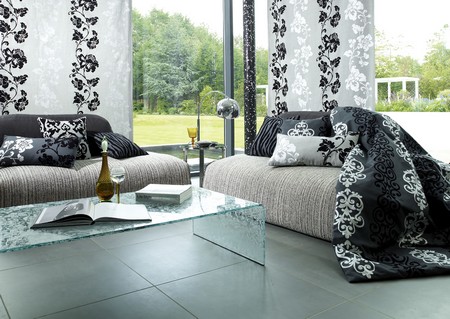Soft furnishings is the collective name given to all the elements of a home that are made of fabric. It includes upholstery, curtains, cushions, quilts, and duvet covers.
Choosing fabric
With such a wide variety to choose from, making a decision can be difficult. Considering these points will help:
- How much wear will fabric need to withstand? Seats need hard-wearing fabric, but cushions do not. So you might choose heavyweight cotton for the sofa, then add a beautiful but less robust silk-based fabric for cushions.
- Easy-care fabrics for upholstery are important if you have children and pets.
- Always view a fabric sample in your home. See how it looks by day and in artificial light.
- Man-made fibres tend to have greater resistance to sun damage than natural ones. Silk is the least resistant
- among natural fabrics; those with woven patterns will be slower to fade in the sun than printed ones.
- Large patterns and dark colours can overpower a small room.
- Few rooms can hold two different patterns. If your sofa has a strong design, balance it with plain curtains.
- Use stripes sparingly and balance them with plain fabric elsewhere in the room.
- Offset pale walls with deep-coloured curtains.
- The fabrics used in a room don’t have to be the same material, but should share similar characteristics. Formal fabrics such as velvet and brocade will group well together in a living room, as will gingham and printed cottons in a kitchen.
Recovering upholstery
There are four options for a covered chair or sofa that is structurally sound, but in need of a replacement cover.
- Disguise it with a throw. This is a blanket-sized piece of fabric that can be draped over a chair or sofa and tucked under the seat. A sofa might require two throws to cover it.
- Stitch a new cover yourself. Making a loose cover that is held in place by a grip-fastener and ties requires careful cutting and accurate sewing skills, but no upholstery skills.
- Buy stretch-covers. These typically consist of material with a high elastic content that stretches over the old cover. This is a budget option.
- Call in a professional upholsterer. He will remove the existing cover and fully fit a new one, with the fabric of your choice. However, this can be as expensive as buying new furniture.
Cushions
- Choose removable covers in washable fabrics.
- Give a fixed cushion a removable cover by unpicking one seam and replacing it with an iron-on grip-fastener.
- Extra-large cushions can double as floor seats.
- Experiment with sizes, shapes, and fabrics, especially if your upholstery is in neutral shades. This is a good way to add new life to tired furniture and a simple way to make a room more colourful and cozy.
- Don’t restrict cushions to the living room. They add colour, comfort, and decoration to kitchen chairs and in bedrooms.
- Choose firm cushions if you are using them to support your back.
